TOYOTA RAV4 2006 Service Repair Manual
Manufacturer: TOYOTA, Model Year: 2006, Model line: RAV4, Model: TOYOTA RAV4 2006Pages: 2000, PDF Size: 45.84 MB
Page 1681 of 2000
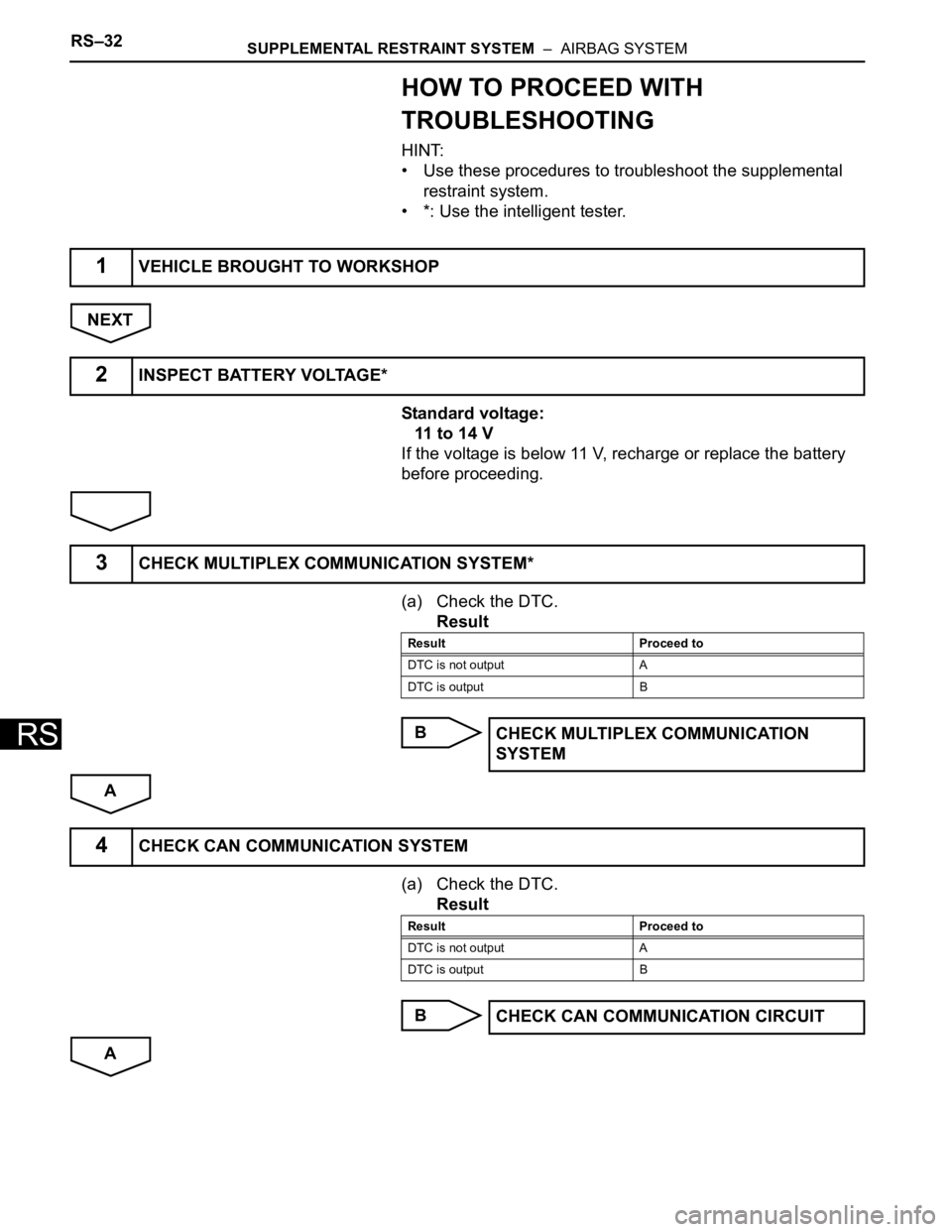
RS–32SUPPLEMENTAL RESTRAINT SYSTEM – AIRBAG SYSTEM
RS
HOW TO PROCEED WITH
TROUBLESHOOTING
HINT:
• Use these procedures to troubleshoot the supplemental
restraint system.
• *: Use the intelligent tester.
NEXT
Standard voltage:
11 to 14 V
If the voltage is below 11 V, recharge or replace the battery
before proceeding.
(a) Check the DTC.
Result
B
A
(a) Check the DTC.
Result
B
A
1VEHICLE BROUGHT TO WORKSHOP
2INSPECT BATTERY VOLTAGE*
3CHECK MULTIPLEX COMMUNICATION SYSTEM*
Result Proceed to
DTC is not output A
DTC is output B
CHECK MULTIPLEX COMMUNICATION
SYSTEM
4CHECK CAN COMMUNICATION SYSTEM
Result Proceed to
DTC is not output A
DTC is output B
CHECK CAN COMMUNICATION CIRCUIT
Page 1682 of 2000
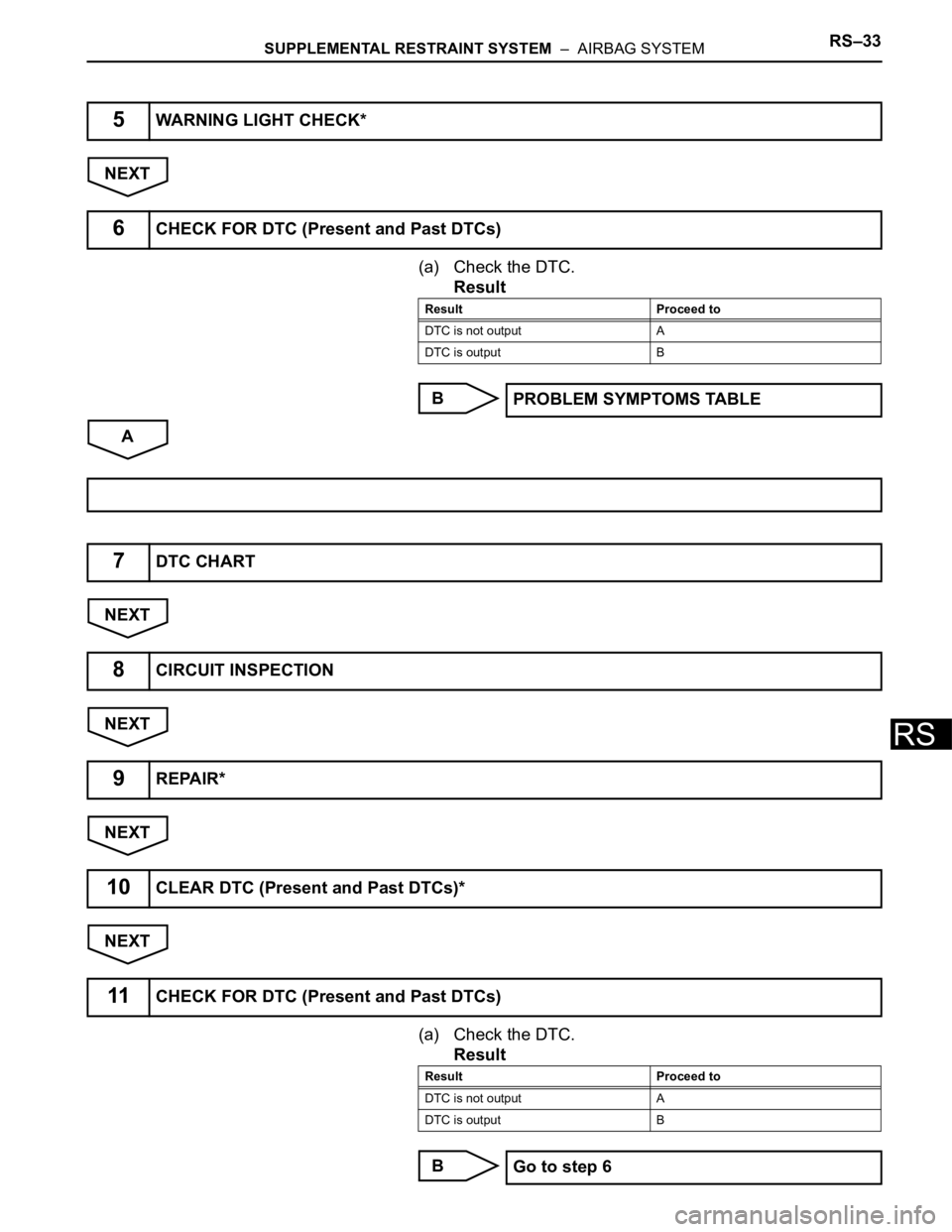
SUPPLEMENTAL RESTRAINT SYSTEM – AIRBAG SYSTEMRS–33
RS
NEXT
(a) Check the DTC.
Result
B
A
NEXT
NEXT
NEXT
NEXT
(a) Check the DTC.
Result
B
5WARNING LIGHT CHECK*
6CHECK FOR DTC (Present and Past DTCs)
Result Proceed to
DTC is not output A
DTC is output B
PROBLEM SYMPTOMS TABLE
7DTC CHART
8CIRCUIT INSPECTION
9REPAIR*
10CLEAR DTC (Present and Past DTCs)*
11CHECK FOR DTC (Present and Past DTCs)
Result Proceed to
DTC is not output A
DTC is output B
Go to step 6
Page 1683 of 2000
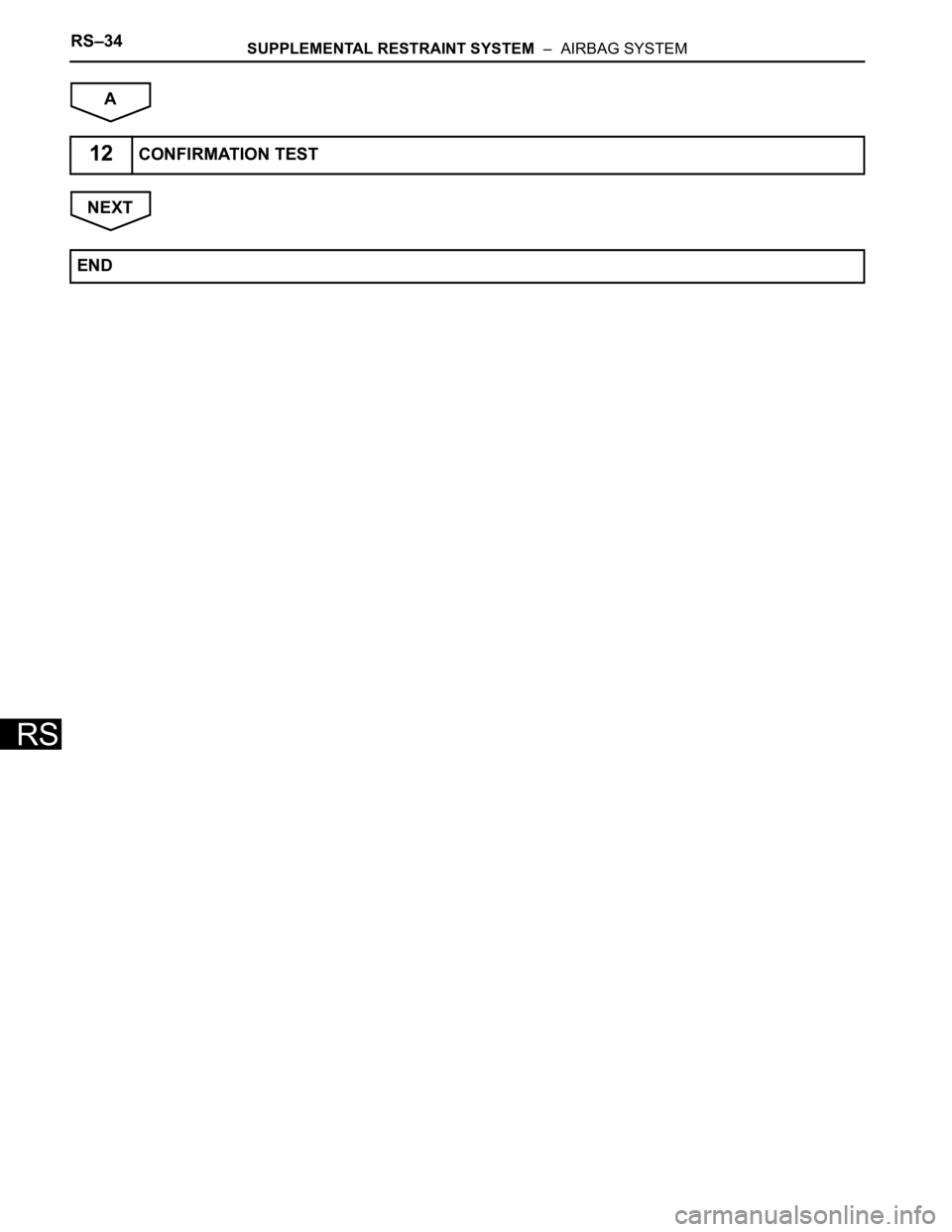
RS–34SUPPLEMENTAL RESTRAINT SYSTEM – AIRBAG SYSTEM
RS
A
NEXT
12CONFIRMATION TEST
END
Page 1684 of 2000
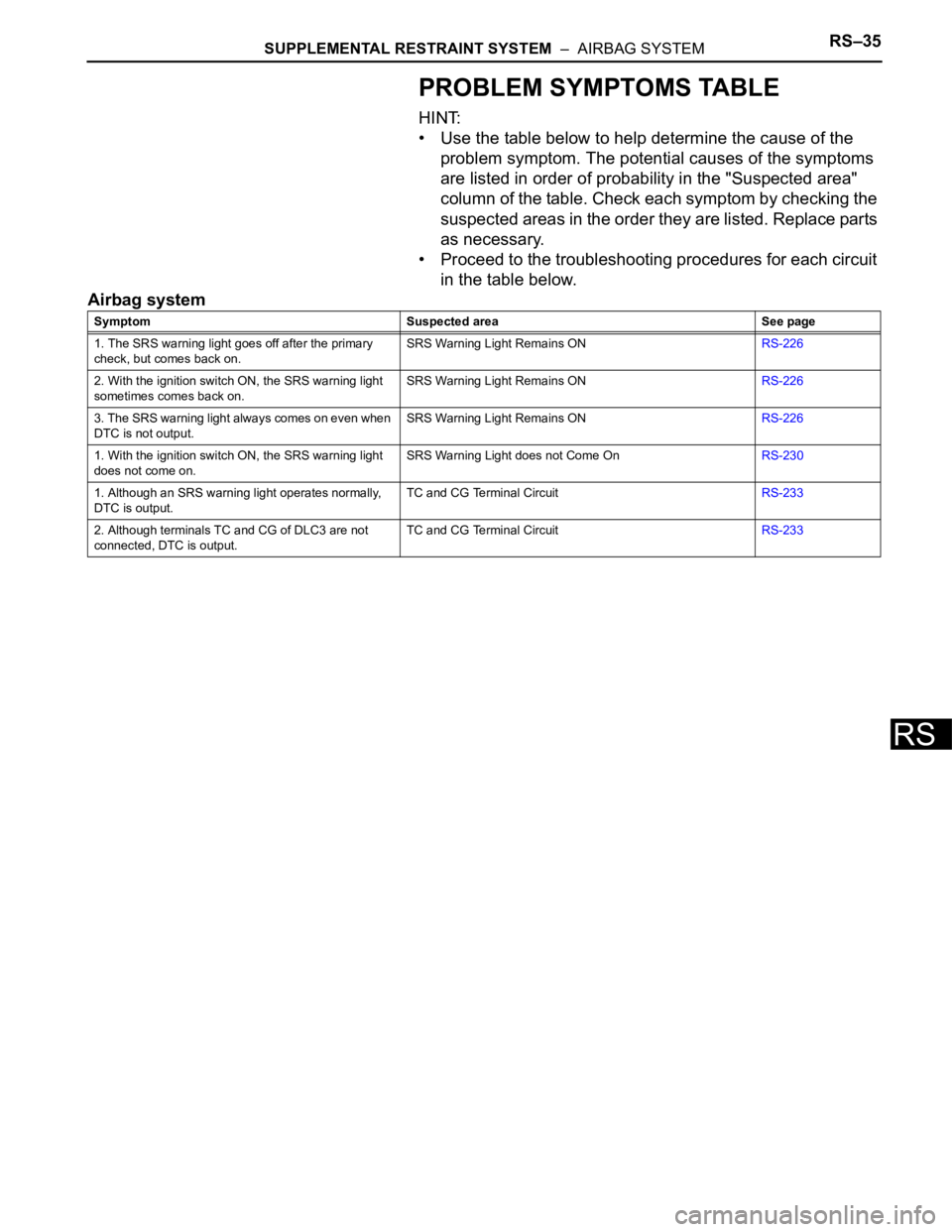
SUPPLEMENTAL RESTRAINT SYSTEM – AIRBAG SYSTEMRS–35
RS
PROBLEM SYMPTOMS TABLE
HINT:
• Use the table below to help determine the cause of the
problem symptom. The potential causes of the symptoms
are listed in order of probability in the "Suspected area"
column of the table. Check each symptom by checking the
suspected areas in the order they are listed. Replace parts
as necessary.
• Proceed to the troubleshooting procedures for each circuit
in the table below.
Airbag system
Symptom Suspected area See page
1. The SRS warning light goes off after the primary
check, but comes back on.SRS Warning Light Remains ONRS-226
2. With the ignition switch ON, the SRS warning light
sometimes comes back on.SRS Warning Light Remains ONRS-226
3. The SRS warning light always comes on even when
DTC is not output.SRS Warning Light Remains ONRS-226
1. With the ignition switch ON, the SRS warning light
does not come on.SRS Warning Light does not Come OnRS-230
1. Although an SRS warning light operates normally,
DTC is output.TC and CG Terminal CircuitRS-233
2. Although terminals TC and CG of DLC3 are not
connected, DTC is output.TC and CG Terminal CircuitRS-233
Page 1685 of 2000
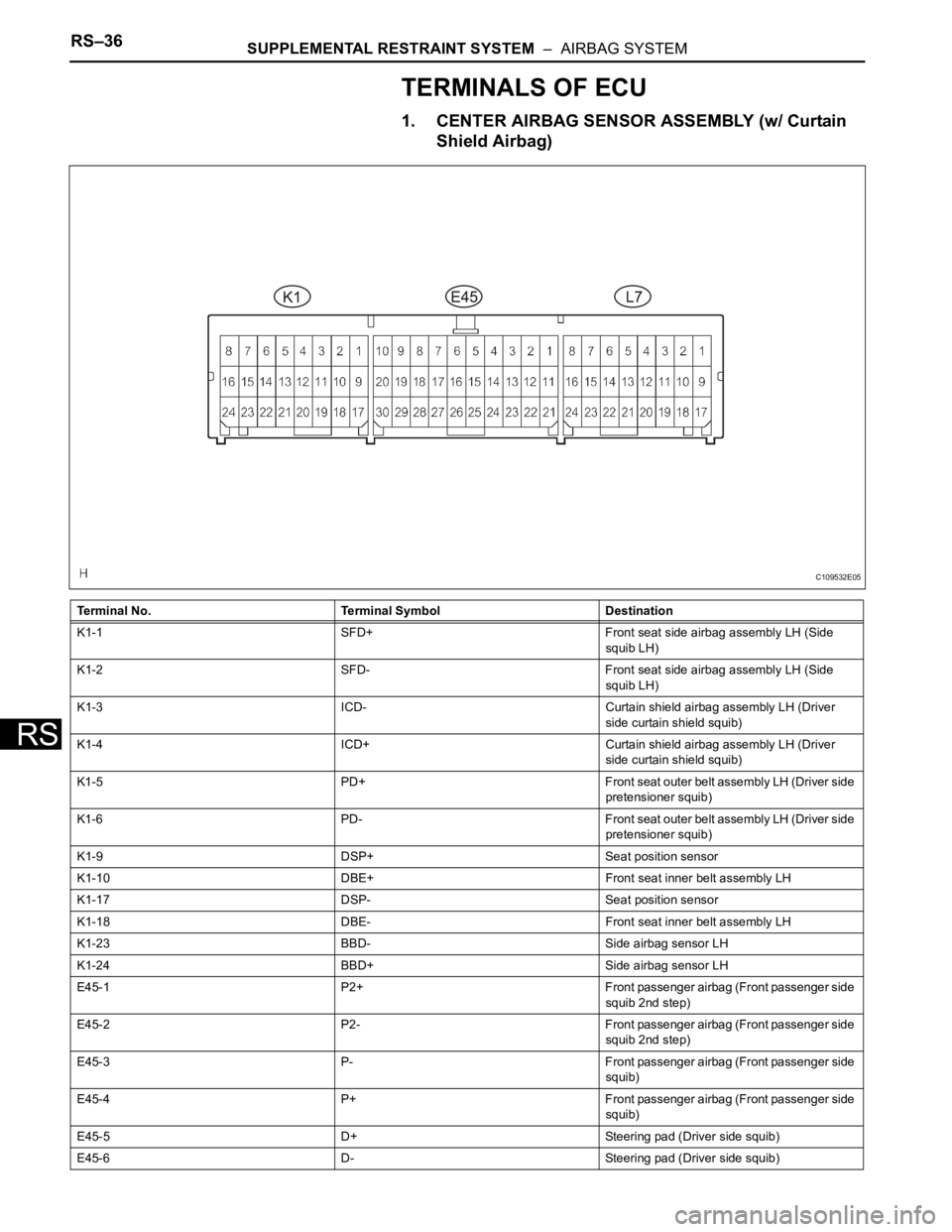
RS–36SUPPLEMENTAL RESTRAINT SYSTEM – AIRBAG SYSTEM
RS
TERMINALS OF ECU
1. CENTER AIRBAG SENSOR ASSEMBLY (w/ Curtain
Shield Airbag)
Terminal No. Terminal Symbol Destination
K1-1 SFD+ Front seat side airbag assembly LH (Side
squib LH)
K1-2 SFD- Front seat side airbag assembly LH (Side
squib LH)
K1-3 ICD- Curtain shield airbag assembly LH (Driver
side curtain shield squib)
K1-4 ICD+ Curtain shield airbag assembly LH (Driver
side curtain shield squib)
K1-5 PD+ Front seat outer belt assembly LH (Driver side
pretensioner squib)
K1-6 PD- Front seat outer belt assembly LH (Driver side
pretensioner squib)
K1-9 DSP+ Seat position sensor
K1-10 DBE+ Front seat inner belt assembly LH
K1-17 DSP- Seat position sensor
K1-18 DBE- Front seat inner belt assembly LH
K1-23 BBD- Side airbag sensor LH
K1-24 BBD+ Side airbag sensor LH
E45-1 P2+ Front passenger airbag (Front passenger side
squib 2nd step)
E45-2 P2- Front passenger airbag (Front passenger side
squib 2nd step)
E45-3 P- Front passenger airbag (Front passenger side
squib)
E45-4 P+ Front passenger airbag (Front passenger side
squib)
E45-5 D+ Steering pad (Driver side squib)
E45-6 D- Steering pad (Driver side squib)
C109532E05
Page 1686 of 2000
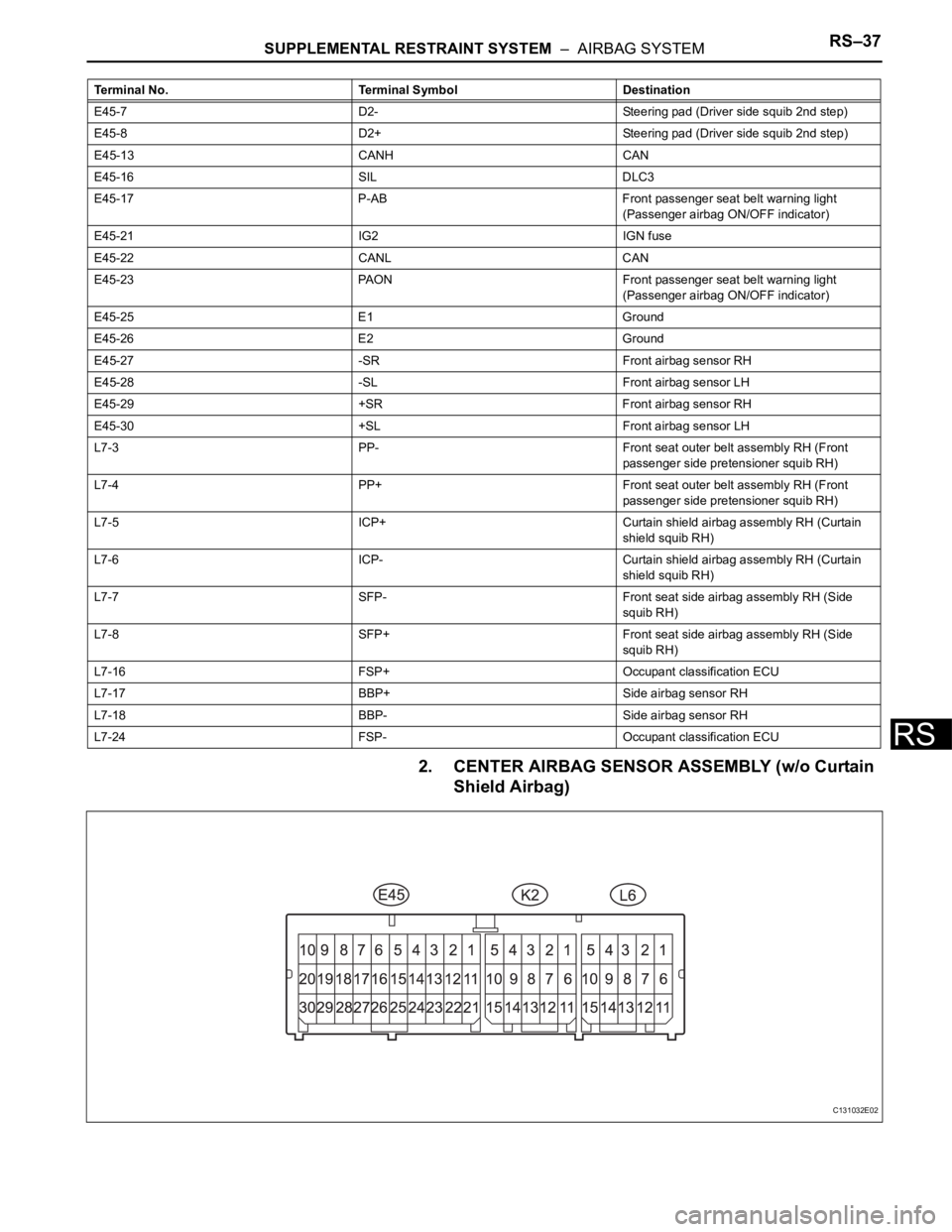
SUPPLEMENTAL RESTRAINT SYSTEM – AIRBAG SYSTEMRS–37
RS
2. CENTER AIRBAG SENSOR ASSEMBLY (w/o Curtain
Shield Airbag)
E45-7 D2- Steering pad (Driver side squib 2nd step)
E45-8 D2+ Steering pad (Driver side squib 2nd step)
E45-13 CANH CAN
E45-16 SIL DLC3
E45-17 P-AB Front passenger seat belt warning light
(Passenger airbag ON/OFF indicator)
E45-21 IG2 IGN fuse
E45-22 CANL CAN
E45-23 PAON Front passenger seat belt warning light
(Passenger airbag ON/OFF indicator)
E45-25 E1 Ground
E45-26 E2 Ground
E45-27 -SR Front airbag sensor RH
E45-28 -SL Front airbag sensor LH
E45-29 +SR Front airbag sensor RH
E45-30 +SL Front airbag sensor LH
L7-3 PP- Front seat outer belt assembly RH (Front
passenger side pretensioner squib RH)
L7-4 PP+ Front seat outer belt assembly RH (Front
passenger side pretensioner squib RH)
L7-5 ICP+ Curtain shield airbag assembly RH (Curtain
shield squib RH)
L7-6 ICP- Curtain shield airbag assembly RH (Curtain
shield squib RH)
L7-7 SFP- Front seat side airbag assembly RH (Side
squib RH)
L7-8 SFP+ Front seat side airbag assembly RH (Side
squib RH)
L7-16 FSP+ Occupant classification ECU
L7-17 BBP+ Side airbag sensor RH
L7-18 BBP- Side airbag sensor RH
L7-24 FSP- Occupant classification ECU Terminal No. Terminal Symbol Destination
C131032E02
Page 1687 of 2000
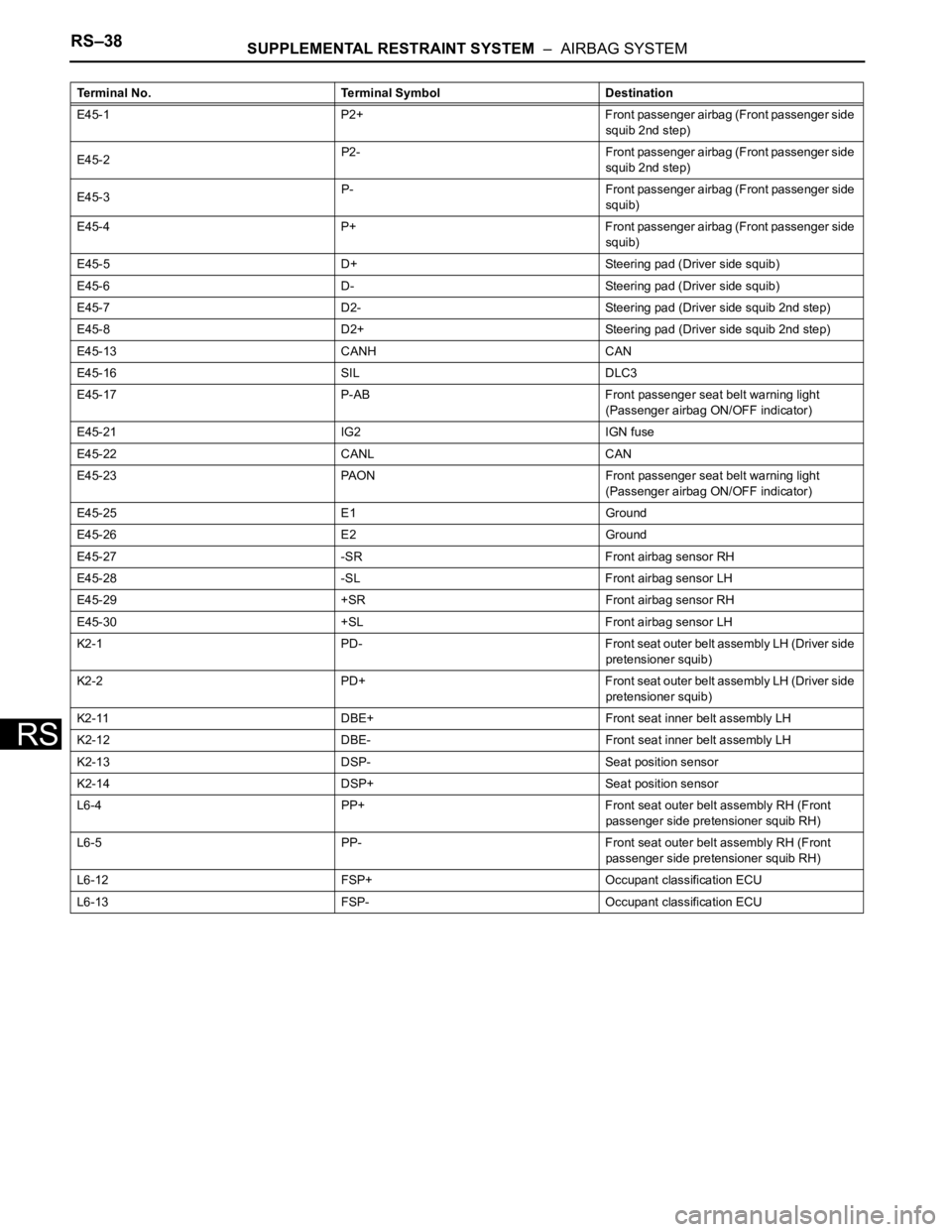
RS–38SUPPLEMENTAL RESTRAINT SYSTEM – AIRBAG SYSTEM
RS
Terminal No. Terminal Symbol Destination
E45-1 P2+ Front passenger airbag (Front passenger side
squib 2nd step)
E45-2P2- Front passenger airbag (Front passenger side
squib 2nd step)
E45-3P- Front passenger airbag (Front passenger side
squib)
E45-4 P+ Front passenger airbag (Front passenger side
squib)
E45-5 D+ Steering pad (Driver side squib)
E45-6 D- Steering pad (Driver side squib)
E45-7 D2- Steering pad (Driver side squib 2nd step)
E45-8 D2+ Steering pad (Driver side squib 2nd step)
E45-13 CANH CAN
E45-16 SIL DLC3
E45-17 P-AB Front passenger seat belt warning light
(Passenger airbag ON/OFF indicator)
E45-21 IG2 IGN fuse
E45-22 CANL CAN
E45-23 PAON Front passenger seat belt warning light
(Passenger airbag ON/OFF indicator)
E45-25 E1 Ground
E45-26 E2 Ground
E45-27 -SR Front airbag sensor RH
E45-28 -SL Front airbag sensor LH
E45-29 +SR Front airbag sensor RH
E45-30 +SL Front airbag sensor LH
K2-1 PD- Front seat outer belt assembly LH (Driver side
pretensioner squib)
K2-2 PD+ Front seat outer belt assembly LH (Driver side
pretensioner squib)
K2-11 DBE+ Front seat inner belt assembly LH
K2-12 DBE- Front seat inner belt assembly LH
K2-13 DSP- Seat position sensor
K2-14 DSP+ Seat position sensor
L6-4 PP+ Front seat outer belt assembly RH (Front
passenger side pretensioner squib RH)
L6-5 PP- Front seat outer belt assembly RH (Front
passenger side pretensioner squib RH)
L6-12 FSP+ Occupant classification ECU
L6-13 FSP- Occupant classification ECU
Page 1688 of 2000
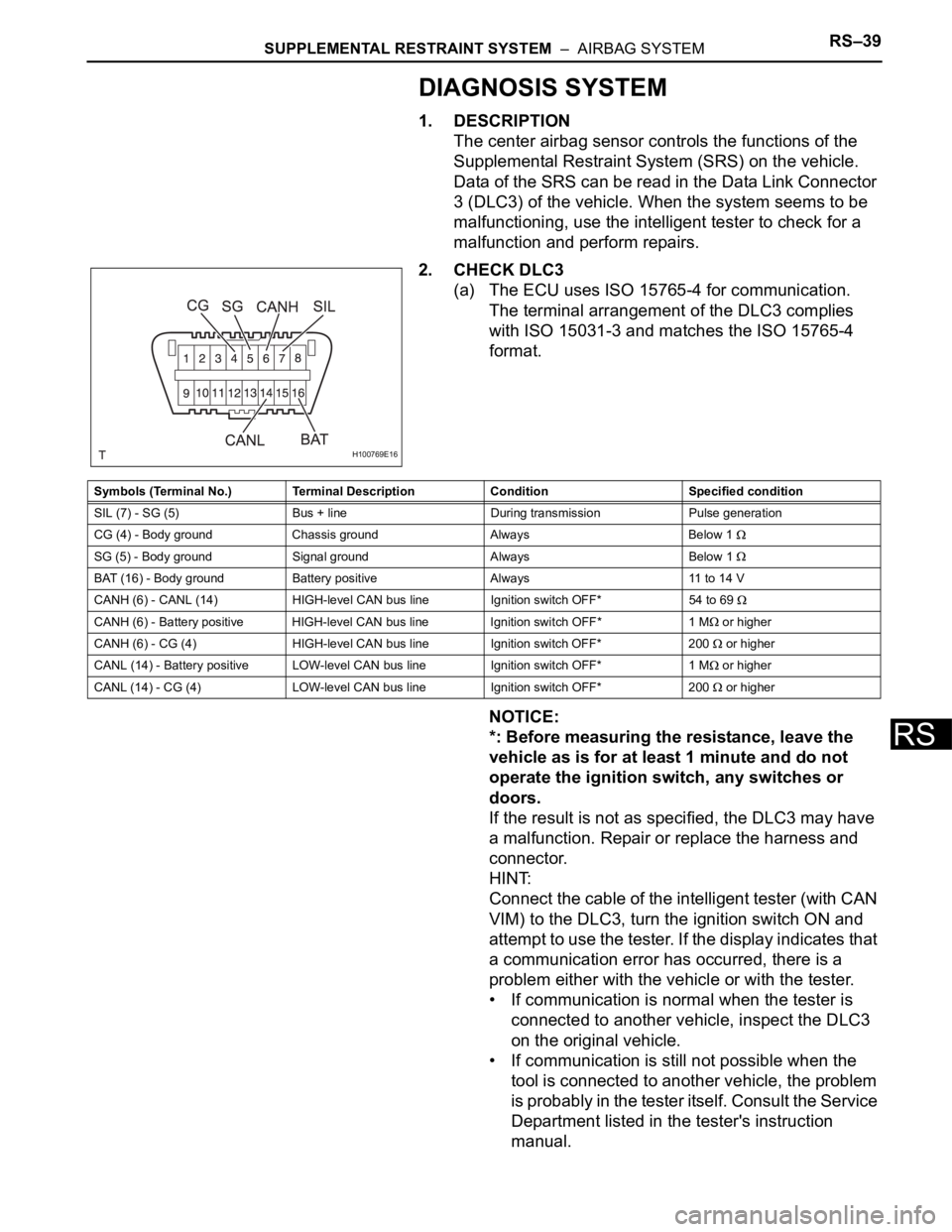
SUPPLEMENTAL RESTRAINT SYSTEM – AIRBAG SYSTEMRS–39
RS
DIAGNOSIS SYSTEM
1. DESCRIPTION
The center airbag sensor controls the functions of the
Supplemental Restraint System (SRS) on the vehicle.
Data of the SRS can be read in the Data Link Connector
3 (DLC3) of the vehicle. When the system seems to be
malfunctioning, use the intelligent tester to check for a
malfunction and perform repairs.
2. CHECK DLC3
(a) The ECU uses ISO 15765-4 for communication.
The terminal arrangement of the DLC3 complies
with ISO 15031-3 and matches the ISO 15765-4
format.
NOTICE:
*: Before measuring the resistance, leave the
vehicle as is for at least 1 minute and do not
operate the ignition switch, any switches or
doors.
If the result is not as specified, the DLC3 may have
a malfunction. Repair or replace the harness and
connector.
HINT:
Connect the cable of the intelligent tester (with CAN
VIM) to the DLC3, turn the ignition switch ON and
attempt to use the tester. If the display indicates that
a communication error has occurred, there is a
problem either with the vehicle or with the tester.
• If communication is normal when the tester is
connected to another vehicle, inspect the DLC3
on the original vehicle.
• If communication is still not possible when the
tool is connected to another vehicle, the problem
is probably in the tester itself. Consult the Service
Department listed in the tester's instruction
manual.
H100769E16
Symbols (Terminal No.) Terminal Description Condition Specified condition
SIL (7) - SG (5) Bus + line During transmission Pulse generation
CG (4) - Body ground Chassis ground Always Below 1
SG (5) - Body ground Signal ground Always Below 1
BAT (16) - Body ground Battery positive Always 11 to 14 V
CANH (6) - CANL (14) HIGH-level CAN bus line Ignition switch OFF*54 to 69
CANH (6) - Battery positive HIGH-level CAN bus line Ignition switch OFF* 1 M or higher
CANH (6) - CG (4) HIGH-level CAN bus line Ignition switch OFF* 200
or higher
CANL (14) - Battery positive LOW-level CAN bus line Ignition switch OFF* 1 M
or higher
CANL (14) - CG (4) LOW-level CAN bus line Ignition switch OFF* 200
or higher
Page 1689 of 2000
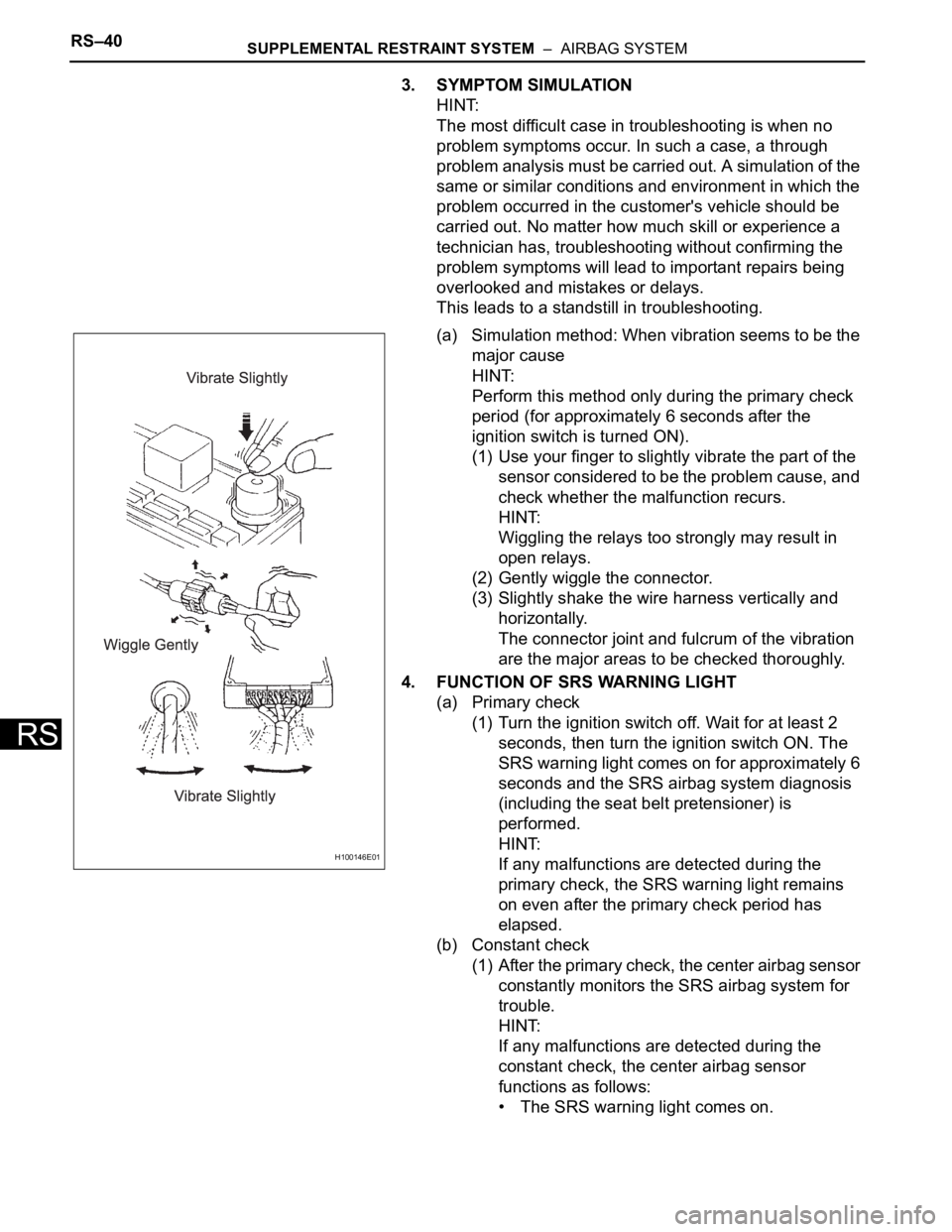
RS–40SUPPLEMENTAL RESTRAINT SYSTEM – AIRBAG SYSTEM
RS
3. SYMPTOM SIMULATION
HINT:
The most difficult case in troubleshooting is when no
problem symptoms occur. In such a case, a through
problem analysis must be carried out. A simulation of the
same or similar conditions and environment in which the
problem occurred in the customer's vehicle should be
carried out. No matter how much skill or experience a
technician has, troubleshooting without confirming the
problem symptoms will lead to important repairs being
overlooked and mistakes or delays.
This leads to a standstill in troubleshooting.
(a) Simulation method: When vibration seems to be the
major cause
HINT:
Perform this method only during the primary check
period (for approximately 6 seconds after the
ignition switch is turned ON).
(1) Use your finger to slightly vibrate the part of the
sensor considered to be the problem cause, and
check whether the malfunction recurs.
HINT:
Wiggling the relays too strongly may result in
open relays.
(2) Gently wiggle the connector.
(3) Slightly shake the wire harness vertically and
horizontally.
The connector joint and fulcrum of the vibration
are the major areas to be checked thoroughly.
4. FUNCTION OF SRS WARNING LIGHT
(a) Primary check
(1) Turn the ignition switch off. Wait for at least 2
seconds, then turn the ignition switch ON. The
SRS warning light comes on for approximately 6
seconds and the SRS airbag system diagnosis
(including the seat belt pretensioner) is
performed.
HINT:
If any malfunctions are detected during the
primary check, the SRS warning light remains
on even after the primary check period has
elapsed.
(b) Constant check
(1) After the primary check, the center airbag sensor
constantly monitors the SRS airbag system for
trouble.
HINT:
If any malfunctions are detected during the
constant check, the center airbag sensor
functions as follows:
• The SRS warning light comes on.
H100146E01
Page 1690 of 2000
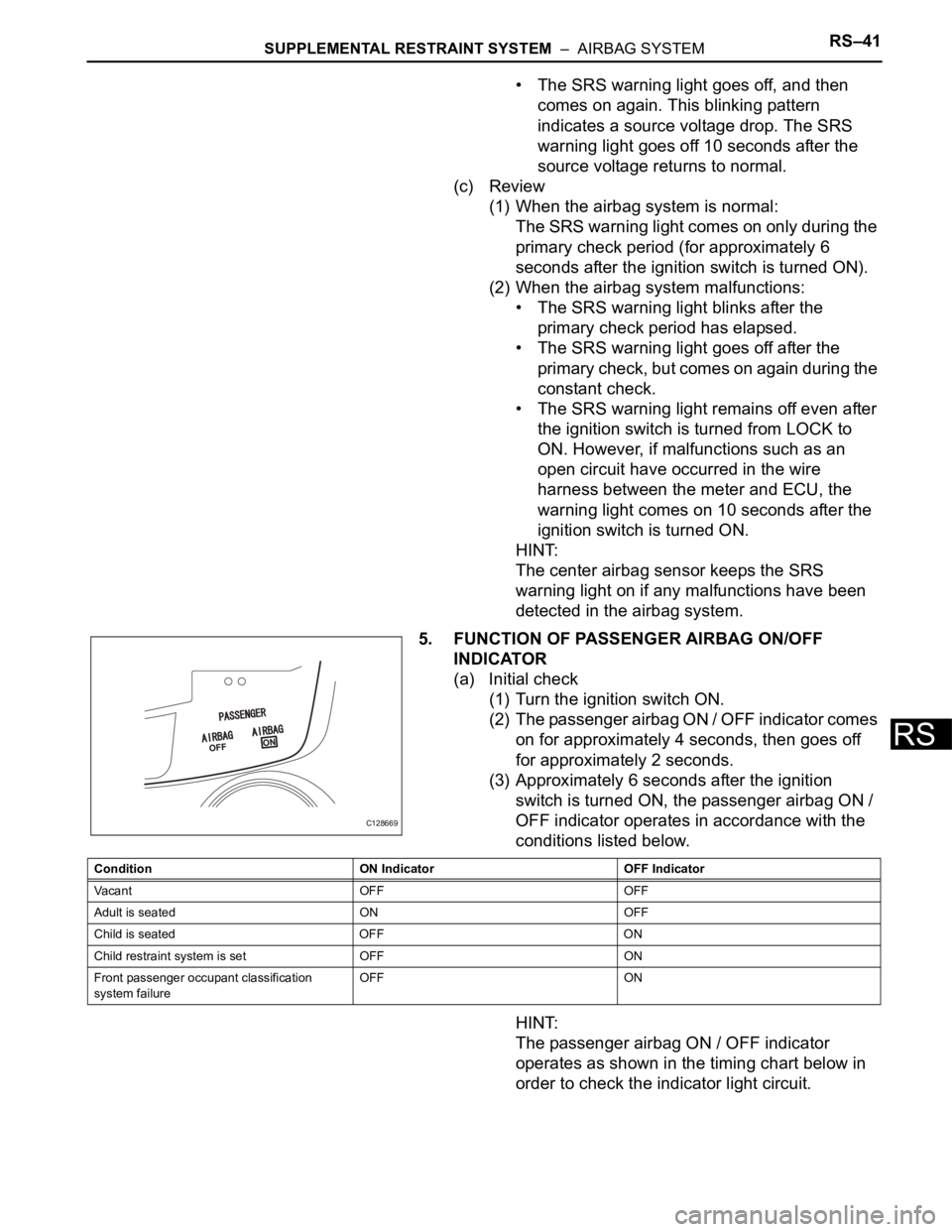
SUPPLEMENTAL RESTRAINT SYSTEM – AIRBAG SYSTEMRS–41
RS
• The SRS warning light goes off, and then
comes on again. This blinking pattern
indicates a source voltage drop. The SRS
warning light goes off 10 seconds after the
source voltage returns to normal.
(c) Review
(1) When the airbag system is normal:
The SRS warning light comes on only during the
primary check period (for approximately 6
seconds after the ignition switch is turned ON).
(2) When the airbag system malfunctions:
• The SRS warning light blinks after the
primary check period has elapsed.
• The SRS warning light goes off after the
primary check, but comes on again during the
constant check.
• The SRS warning light remains off even after
the ignition switch is turned from LOCK to
ON. However, if malfunctions such as an
open circuit have occurred in the wire
harness between the meter and ECU, the
warning light comes on 10 seconds after the
ignition switch is turned ON.
HINT:
The center airbag sensor keeps the SRS
warning light on if any malfunctions have been
detected in the airbag system.
5. FUNCTION OF PASSENGER AIRBAG ON/OFF
INDICATOR
(a) Initial check
(1) Turn the ignition switch ON.
(2) The passenger airbag ON / OFF indicator comes
on for approximately 4 seconds, then goes off
for approximately 2 seconds.
(3) Approximately 6 seconds after the ignition
switch is turned ON, the passenger airbag ON /
OFF indicator operates in accordance with the
conditions listed below.
HINT:
The passenger airbag ON / OFF indicator
operates as shown in the timing chart below in
order to check the indicator light circuit.
C128669
Condition ON Indicator OFF Indicator
Va c a n t O F F O F F
Adult is seated ON OFF
Child is seated OFF ON
Child restraint system is set OFF ON
Front passenger occupant classification
system failureOFF ON